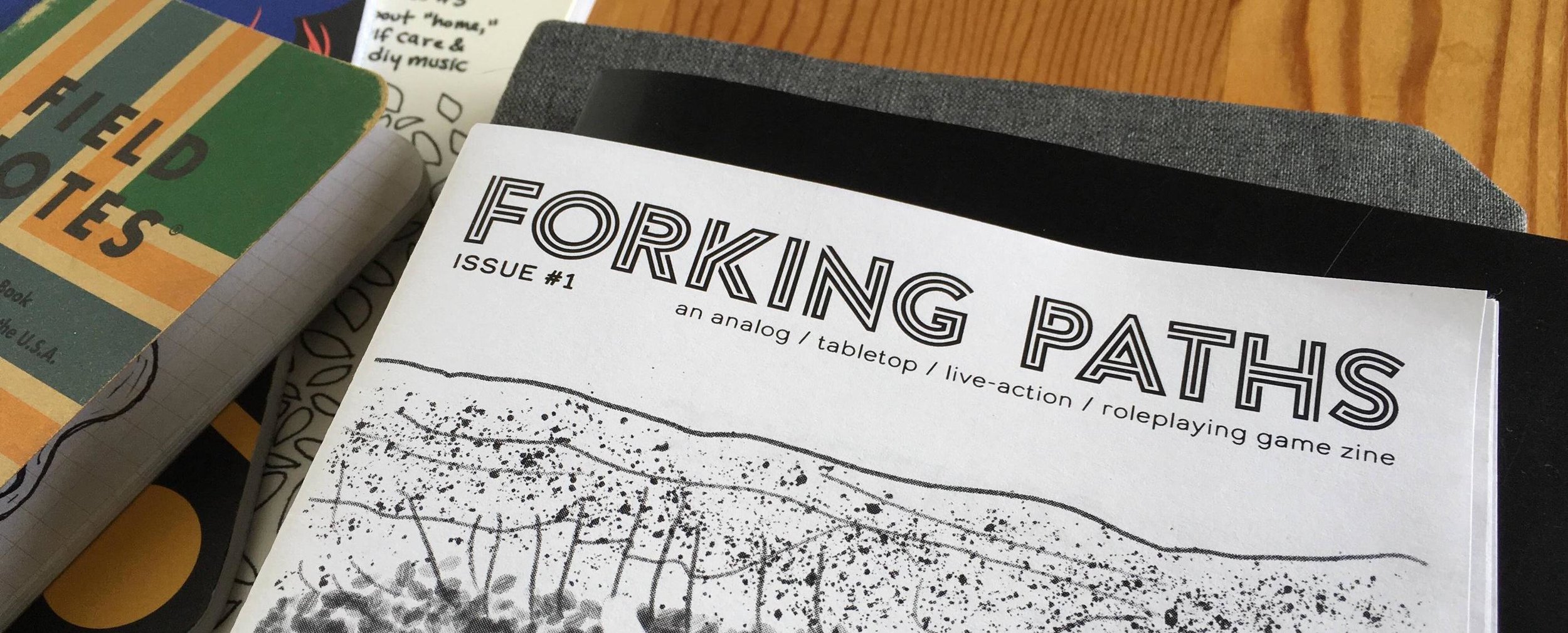After I started working on the Viridian Maw in earnest, but before I hit on using it for an RPG zine, I was inspired by a wave of pretty cool one-page settings going around in RPG spheres. I think the first one I saw was either the Ashlands or Sorabu Forest, both of which seem to trace back to The Savage Tundra of the Winter King and/or an earlier Reddit post that first spawned the idea. I liked how the brevity of the format meant packing a lot into each included detail, and letting mystery & suggestion do a lot of heavy lifting. The zine I ended up with is a lot longer than one page, but a lot of that ethos is still present in how I wrote it.
At the end of making the zine, I wanted to see what I could distill back into something like the one-page setting format that helped shape my ideas. Both as an exercise, and as in-kind sharing with everyone else who generously shared their ideas & work. Since this issue of the zine doesn’t delve much into specific characters, I wanted to focus on a sense of place above all for this one-pager. I wanted to include one of the random tables too, since random tables are great! The random ruins table seemed the most “portable”, so it made sense to include. (The random encounters table leans heavily on referencing the unique flora & fauna described in the zine, which I didn’t think I could squeeze into a one-page format in a satisfactory way).
I rewrote the entries for each hexmap location into a series of descriptive paragraphs, took the setting pitch for the Viridian Maw from the zine introduction and tightened it up for space, and fiddled with layout & details until I was happy. Which I am! If I had room, I might break out the little adventure seeds & such into their own sections, but as it stands weaving them into the location descriptions worked best to fit everything in. Since my personal preference is to leave more blanks, I’m calling my thing a “setting kit” rather than just a setting. It asks for a little more input from the user (like maybe some rolls on the random ruins table!) to get things lined up and pointed toward adventure.
As far as how to use it, I’d say there’s honestly no wrong way. For example, with the random ruins table, you could roll up 1-3 ruins per hex in advance and see which ones the players stumble across as they venture into the Maw. If you’re into low-prep GMing (like me!) you could wait until players go nosing around for interesting sites, or do something like climb a tree and ask what they see, then roll up ruins as-needed in response. You could stick strictly to the roll results; re-roll things that don’t feel right or make sense; pick arbitrarily from the lists — all are perfectly legit routes to go!
One thing I considered including in the zine itself but cut for space was some info about my influences for the Viridian Maw itself. Here’s what I wrote before deciding it didn’t have a good place to fit (links added for your convenience):
A few different influences set me to whipping up RPG material in this vein. The biggest probably being a few novels by Jeff VanderMeer: the Southern Reach trilogy (Annihilation in particular) and Borne (plus its follow-up novella, The Strange Bird). All are great, and I highly recommend reading them. Each feels a little like sitting in on a wildly creative run of Apocalypse World sessions, and it was easy to be inspired by them.
Parallel to that, I’d been nursing ideas for a “fungal megadungeon” for a while, writing down bits and pieces as I ran my players through the Barrowmaze (a recent megadungeon emerging from the old-school RPG realm). It is a truth universally acknowledged that a GM playing anything is only a hair’s-breadth away from making their own version of it, and I’m no exception.
So the main ingredients of this stew are those weird ecologies from VanderMeer’s books, a general interest in wilderness sandboxes and megadungeons therein, and being very up for excuses to read about fungus. Mushrooms: A Natural and Cultural History, by Nicholas P. Money, was great fuel in that regard. Mostly I learned that fungi are weird enough in the real world that any made-up mushrooms from me could be pretty strange without tripping my personal “too much” filter.
For making my ideas gameable without being too limited to this or that specific system, I looked to the examples of a couple setting books that do that. The Hot Springs Island sandbox material and Veins of the Earth were great examples of making interesting creature entries without being too tied to any one system. Both gave me some good ideas for dense, useful random tables, and I also revisited the Oracles from In a Wicked Age on that front.
I drew on some old or unfinished game designs of my own, too. Most of those aren’t in a form anyone could check out, but one is: The Caravan, a 200-word microgame published here:
https://orbis-tertius.org/the-caravan
Anyway, check out the one-page setting version of the Viridian Maw! And if all or any of the above piques your interest, there’s the full issue of Forking Paths I adapted it from, too. :)




